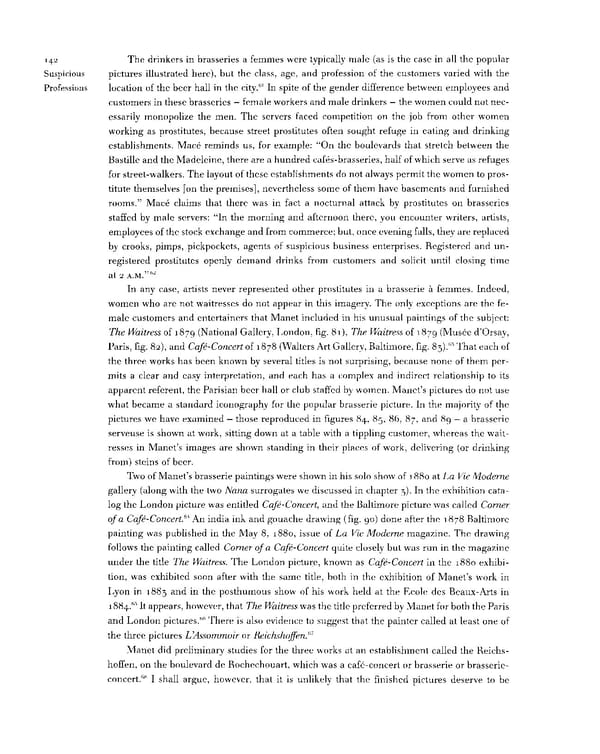142 The drinkers in brasseries a femmes were typically male (as is the case in all the popular Suspicious pictures illustrated here), but the class, age, and profession of the customers varied with the Professions 61 location of the beer hall in the city. In spite of the gender difference between employees and customers in these brasseries — female workers and male drinkers — the women could not nec- essarily monopolize the men. The servers faced competition on the job from other women working as prostitutes, because street prostitutes often sought refuge in eating and drinking establishments. Mace reminds us, for example: "On the boulevards that stretch between the Bastille and the Madeleine, there are a hundred cafes-brasseries, half of which serve as refuges for street-walkers. The layout of these establishments do not always permit the women to pros- titute themselves [on the premises], nevertheless some of them have basements and furnished rooms." Mace claims that there was in fact a nocturnal attack by prostitutes on brasseries staffed by male servers: "In the morning and afternoon there, you encounter writers, artists, employees of the stock exchange and from commerce; but, once evening falls, they are replaced by crooks, pimps, pickpockets, agents of suspicious business enterprises. Registered and un- registered prostitutes openly demand drinks from customers and solicit until closing time at 2 A.M."62 In any case, artists never represented other prostitutes in a brasserie a femmes. Indeed, women who are not waitresses do not appear in this imagery. The only exceptions are the fe- male customers and entertainers that Manet included in his unusual paintings of the subject: The Waitress of 1879 (National Gallery, London, fig. 81), The Waitress of 1879 (Musee d'Orsay, 63 Paris, fig. 82), and Cafe-Concert of 1878 (Walters Art Gallery, Baltimore, fig. Ss). That each of the three works has been known by several titles is not surprising, because none of them per- mits a clear and easy interpretation, and each has a complex and indirect relationship to its apparent referent, the Parisian beer hall or club staffed by women. Manet's pictures do not use what became a standard iconography for the popular brasserie picture. In the majority of the pictures we have examined — those reproduced in figures 84, 85, 86, 87, and 89 — a brasserie serveuse is shown at work, sitting down at a table with a tippling customer, whereas the wait- resses in Manet's images are shown standing in their places of work, delivering (or drinking from) steins of beer. Two of Manet's brasserie paintings were shown in his solo show of 1880 at La Vie Moderne gallery (along with the two Nana surrogates we discussed in chapter 3). In the exhibition cata- log the London picture was entitled Cafe-Concert, and the Baltimore picture was called Corner 64 of a Cafe-Concert An india ink and gouache drawing (fig. 90) done after the 1878 Baltimore painting was published in the May 8, 1880, issue of La Vie Moderne magazine. The drawing follows the painting called Corner of a Cafe-Concert quite closely but was run in the magazine under the title The Waitress. The London picture, known as Cafe-Concert in the 1880 exhibi- tion, was exhibited soon after with the same title, both in the exhibition of Manet's work in Lyon in 1883 and in the posthumous show of his work held at the Ecole des Beaux-Arts in 1884.65 It appears, however, that The Waitress was the title preferred by Manet for both the Paris 66 and London pictures. There is also evidence to suggest that the painter called at least one of the three pictures LAssommoir or Reichshoffen.67 Manet did preliminary studies for the three works at an establishment called the Reichs- hoffen, on the boulevard de Rochechouart, which was a cafe-concert or brasserie or brasserie- 68 concert. I shall argue, however, that it is unlikely that the finished pictures deserve to be
 Prostitution & Impressionists Page 162 Page 164
Prostitution & Impressionists Page 162 Page 164